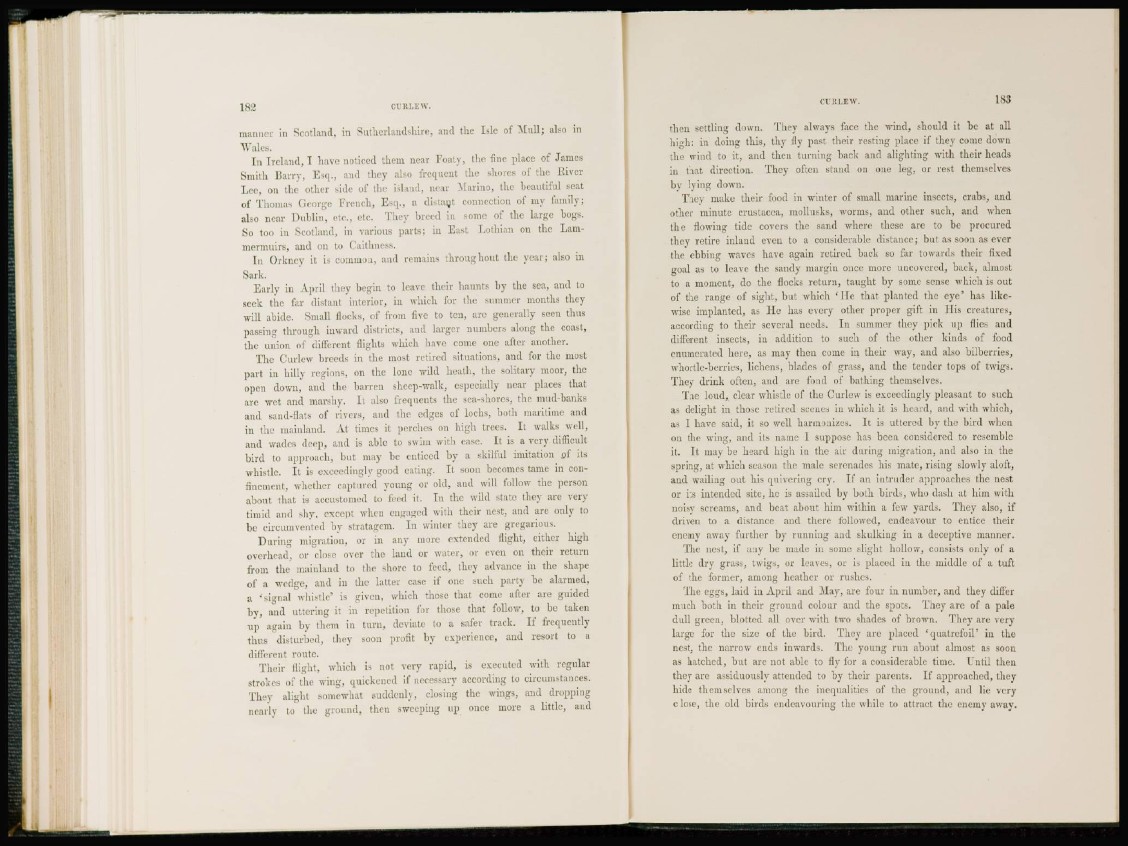
182 CURLEW.
manner in Scotland, in Satherlandshire, and the Isle of Mull; also in
Wales.
I n Ireland, I have noticed them near Foaty, the fine place of James
Smith Carry, Esq., and they also frequent the shores of the River
Lee, on the other side of the island, near Marino, the beautiful seat
of Thomas George French, Esq., a distant connection of my family;
also near Dublin, etc., etc. They breed in some of the large bogs.
So too in Scotland, in various parts; in East Lothian on the Lammermuirs,
and on to Caithness.
In Orknev it is common, and remains throughout the year; also in
Sark.
Early in April they begin to leave their haunts by the sea, and to
seek the far distant interior, in which for the summer months they
will abide. Small flocks, of from five to ten, are generally seen thus
passing through inward districts, and larger numbers along the coast,
the union of different flights which have come one after another.
The Curlew breeds in the most retired situations, and for the most
part in hilly regions, on the lone wild heath, the solitary moor, the
open down, and the barren shecp-walk, especially near places that
are wet and marshy. It also frequents the sea-shores, the mud-hanks
and sand-flats of rivers, and the edges of lochs, both maritime and
in the mainland. At times it perches on high trees. It walks well,
and wades deep, and is able to swim with ease. It is a very difficult
bird to approach, but may be enticed by a skilful imitation of its
whistle. It is exceedingly good eating. It soon becomes tame in confinement,
whether captured young or old, and will follow the person
about, that, is accustomed to feed it. In the wild state they are very
timid and shy, except when engaged with their nest, and are only to
be circumvented by stratagem. In winter they are gregarious.
During migration, or in any more extended flight, either high
overhead, or close over the land or water, or even on their return
from the mainland to the shore to feed, they advance in the shape
of a wedge, and in the latter case if one such party be alarmed,
a 'signal whistle' is given, which those that come after are guided
by, and uttering it in repetition for those that follow, to be taken
up again by them in turn, deviate to a safer track. If frequently
thus disturbed, they soon profit by experience, and resort to a
different route.
Their flight, which is not very rapid, is executed with regular
strokes of the wing, quickened if necessary according to circumstances.
They alight somewhat suddenly, closing the wings, and dropping
nearly to the ground, then sweeping up once more a little, and
CURLEW. 1 8 3
then settling down. They always face the wind, should it be at all
high: in doing this, thy fly past their resting place if they come down
the wind to it, and then turning back and alighting with their heads
iu that direction. They often stand on one leg, or rest themselves
by lying down.
They make their food in winter of small marine insects, crabs, and
other minute Crustacea, mollusks, worms, and other such, and when
t h e flowing tide covers the sand where these are to be procured
they retire inland even to a considerable distance; but as soon as ever
the ebbing waves have again retired back so far towards their fixed
goal as to leave the sandy margin once more uncovered, back, almost
to a moment, do the flocks return, taught by some sense which is out
of the range of sight, but which ' H e that planted the eye' has likewise
implanted, as He has every other proper gift in His creatures,
according to their several needs. In summer they pick up flies and
different insects, in addition to such of the other kinds of food
enumerated here, as may then come in their way, and also bilberries,
whortle-berrics, lichens, blades of grass, and the tender tops of twigs.
They drink often, and are fond of bathing themselves.
The loud, clear whistle of the Curlew is exceedingly pleasant to such
as delight in those retired scenes in which it is heard, and with which,
as I have said, it so well harmonizes. It is uttered by the bird when
on the wing, and its name 1 suppose has been considered to resemble
it. It may be heard high in the air during migration, and also in the
spring, at which season the male serenades his mate, rising slowly aloft,
and wailing out his quivering cry. If an intruder approaches the nest
or its intended site, he is assailed by both birds, who dash at him with
noisy screams, and beat about him within a few yards. They also, if
driven to a distance and there followed, endeavour to entice their
enemy away further by running and skulking in a deceptive manner.
The nest, if any be made in some slight hollow, consists only of a
little dry grass, twigs, or leaves, or is placed in the middle of a tuft
of the former, among heather or rushes.
The eggs, laid in April and May, are four in number, and they differ
much both in their ground colour and the spots. They are of a pale
dull green, blotted all over with two shades of brown. They are very
large for the size of the bird. They are placed 'quatrcfoiP in the
nest, the narrow ends inwards. The young run about almost as soon
as hatched, but are not able to fly for a considerable time. Until then
they are assiduously attended to by their parents. If approached, they
hide themselves among the inequalities of the ground, and lie very
close, the old birds endeavouring the while to attract the enemy away.